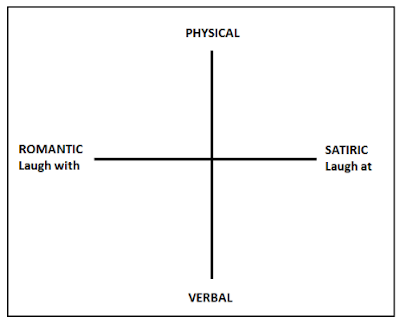The Theory of Laughter
Henri
Bergson’s theory of laughter[1]
divides comedy into four types: verbal/physical and romantic/satiric. This
theory, perfectly applicable to modern comedy, identifies comedic types that
first surfaced in theatrical comic drama and that now appear in the new media.
It can be represented with a simple scheme using two bipolar continuum: the
first continuum has physical comedy on one end and verbal comedy on the other.
It utilizes a traditional distinction between the physical comedy of action,
also called low comedy or farce, and the verbal comedy of repartee, also called
high comedy or wit. This distinction is crucial to the electronic media: radio
is the locus of verbal comedy while television, the only medium that can show
action, most often uses physical comedy.
The second
dimension, on the other hand, follows a standard critical classification scheme
and sets up a continuum that has romantic comedy on one end and satiric comedy
on the other.
The scheme also
makes pretty clear the difference between two types of audience responses:
laughter with the characters and laughter at them.
[1] Stern B.B., "Advertising Comedy in Electronic Drama: the construct, theory and taxonomy”, European Journal of Marketing, 1996
Figure 1: Comedy - four-cell taxonomy

Comments
Post a Comment